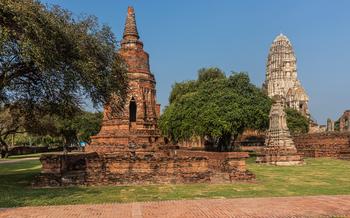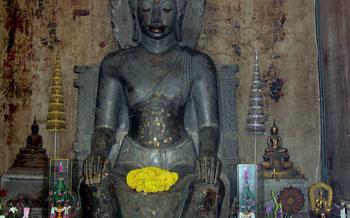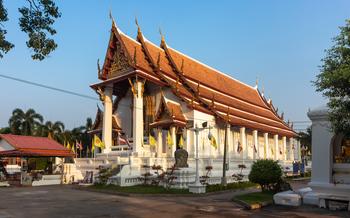
Wat Khao Takhrao
- History of Wat Khao Takhrao
- Location and Accessibility
- Temple Layout and Design
- Main Sanctuary and Buddha Images
- Ordination Hall and Buddhist Teachings
- Surrounding Temples and Structures
- Festivals and Special Events
- Local Beliefs and Superstitions
- Dress Code and Etiquette
- Photography and Videography
- Souvenirs and Local Crafts
- Nearby Attractions and Activities:
- Accessibility for Visitors with Disabilities
- Insider Tip:
History of Wat Khao Takhrao
Perched atop a limestone hill overlooking the picturesque Phetchaburi landscape, Wat Khao Takhrao stands as a testament to the enduring legacy of ancient Thai craftsmanship and religious devotion. The temple's origins trace back to the 16th century, during the reign of King Rama IV, when a revered monk named Luang Phor Thong Suk founded the temple on this sacred site. According to local legend, Luang Phor Thong Suk was guided by a divine dream that revealed the presence of a Buddha image hidden within the hill. Undeterred by the arduous task, he led a group of villagers to excavate the hill, and miraculously, they unearthed a resplendent Buddha image, which became the main object of worship at the newly established temple.
Wat Khao Takhrao's architectural style is a harmonious blend of Thai and Khmer influences, reflecting the rich cultural heritage of the region. The temple complex features intricate carvings, stupas, and a grand staircase that leads to the main sanctuary, where the revered Buddha image resides. Over the centuries, Wat Khao Takhrao has undergone several renovations and restorations to preserve its grandeur and historical significance, ensuring that this sacred site continues to inspire and awe visitors from around the world.
Location and Accessibility
Wat Khao Takhrao is situated in the Phetchaburi Province of Thailand, approximately 120 kilometers southwest of Bangkok. To reach the temple, visitors can opt for public transportation, taxis, or self-drive.
Public Transportation: Regular buses and minivans depart from Bangkok's Southern Bus Terminal to Phetchaburi City. From there, visitors can take a local bus or a tuk-tuk to reach the temple.
Taxis: Taxis can be hired from Bangkok or Phetchaburi City for a convenient and direct journey to Wat Khao Takhrao.
Self-Drive: For those who prefer the flexibility of self-driving, rental cars are available in both Bangkok and Phetchaburi. The temple is accessible via Route 3195 and is well-signposted.
Parking: Ample parking space is available within the temple complex, catering to both cars and tour buses.
Accessibility for Visitors with Disabilities: Wat Khao Takhrao strives to be accessible to visitors of all abilities. The temple features ramps and designated parking spaces for wheelchair users. However, it's advisable to inform the temple authorities in advance if special assistance is required.
Temple Layout and Design
Wat Khao Takhrao's layout exemplifies a harmonious blend of Thai and Khmer architectural influences. As visitors approach the temple, they are greeted by a grand staircase flanked by mythical nāga serpents. The staircase leads to the main sanctuary, the heart of the temple complex. The sanctuary features a distinctive Khmer-style prang, a towering spire that dominates the skyline. The intricately carved pediments and lintels above the doorways showcase scenes from Buddhist mythology and the life of the Buddha.
Within the main sanctuary, visitors can admire the principal Buddha image, a revered object of worship. The Buddha is seated in the bhumisparsha mudra, the gesture of touching the earth, symbolizing his enlightenment and victory over earthly temptations. The walls of the sanctuary are adorned with colorful murals depicting tales from the Jataka, stories of the Buddha's previous lives. These murals offer a glimpse into the rich Buddhist heritage and moral teachings that permeate Thai culture.
Main Sanctuary and Buddha Images
The main sanctuary, known as the viharn, is the heart of the Wat Khao Takhrao temple complex. Inside this sacred chamber, visitors are awestruck by the presence of the principal Buddha image, a colossal and awe-inspiring figure that exudes an aura of peace and serenity. This magnificent statue, crafted from bronze and adorned with intricate gold leaf, is a masterpiece of Buddhist art. It depicts the Buddha in a seated position, his serene countenance and graceful posture radiating compassion and wisdom.
The history of this revered Buddha image is steeped in legend and folklore. According to local tales, the statue was created by a skilled artisan who was guided by divine inspiration. It is believed that the image was cast in a single pouring of molten bronze, a feat that is considered miraculous. The Buddha image is not only a religious icon but also a symbol of the temple's sacredness and a source of profound reverence for the local community.
Devotees from far and wide flock to the main sanctuary to pay homage to the Buddha image and seek blessings. They offer prayers, light incense sticks, and make offerings of flowers and other devotional items. The atmosphere within the viharn is one of deep devotion and tranquility, as visitors immerse themselves in the spiritual energy that permeates this sacred space.
Ordination Hall and Buddhist Teachings
The ordination hall at Wat Khao Takhrao holds immense significance in the Buddhist monastic life. Dedicated to the teachings of Lord Buddha, this sacred space is where young men embark on their journey to becoming ordained monks. The interior of the hall is adorned with intricate murals depicting scenes from the Buddha's life and teachings, as well as beautiful Buddha images that inspire devotion and contemplation.
Ordination ceremonies, known as "Upasampada," are conducted within the ordination hall, marking a profound transition in the life of an individual. During these ceremonies, young men formally renounce their worldly possessions and embrace the monastic lifestyle, guided by the principles of the Buddhist faith. The monks residing at Wat Khao Takhrao play a crucial role in these ceremonies, providing guidance and support to the new initiates as they embark on their spiritual path.
Visitors to Wat Khao Takhrao have the opportunity to learn more about Buddhism and its teachings through interactions with the monks and by observing their daily practices. The temple serves as a center for Buddhist education, where visitors can gain insights into the principles of mindfulness, compassion, and the pursuit of enlightenment.
Surrounding Temples and Structures
In addition to the main sanctuary and ordination hall, the Wat Khao Takhrao complex encompasses several other temples and structures that contribute to its rich historical and architectural heritage. Among these are:
-
Wihan Luang: This is a large assembly hall located to the west of the main sanctuary. It features a distinctive roof design with multiple tiers and gables, supported by intricately carved pillars. The interior of the hall is adorned with murals depicting scenes from the life of Buddha and Thai history.
-
Chedi: Scattered throughout the complex are several chedis, or Buddhist stupas, which serve as monuments to the Buddha and his teachings. These chedis vary in size and shape, some featuring intricate decorative elements such as lotus petals or finials.
-
Sala: The temple grounds also include several sala, or pavilions, which provide visitors with places to rest and shelter from the sun or rain. These sala are often located in scenic spots, offering panoramic views of the surrounding landscape.
Each of these structures plays a unique role in the overall functioning of the temple complex, contributing to its spiritual and cultural significance. Visitors are encouraged to explore these additional temples and structures to gain a deeper understanding of the history and traditions of Wat Khao Takhrao.
Festivals and Special Events
Wat Khao Takhrao is renowned for its vibrant festivals and special events that draw visitors from near and far. The most significant festival is the annual temple fair, which takes place over several days in February or March. During this grand celebration, the temple grounds come alive with colorful decorations, lively music, and a bustling atmosphere. Devotees and visitors alike participate in merit-making activities, offer prayers, and join in the joyous processions that honor the temple's sacred Buddha image.
Other notable events include the Kathin ceremony in October, where new robes are offered to the monks, and the Makha Bucha and Visakha Bucha holidays, which commemorate important Buddhist occasions. These festivals present a unique opportunity to witness the deep devotion and cultural traditions that are an integral part of Thai Buddhism. Visitors are welcome to join in the festivities and experience the vibrant spiritual energy that permeates the temple during these special times.
Local Beliefs and Superstitions
Wat Khao Takhrao is steeped in local beliefs and superstitions that add to its mystique and sacredness. The temple is believed to be a powerful spiritual site with protective energies. Many visitors come to the temple to seek blessings, make offerings, and pray for good luck, health, and prosperity.
One of the most popular beliefs associated with the temple is the power of amulets and talismans. These sacred objects, often made from blessed metals or inscribed with sacred texts, are believed to possess protective powers. Visitors can purchase amulets at the temple to wear for protection or give as gifts to loved ones.
Another local belief is that the temple is home to a powerful spirit known as the "Chao Pho Khao Takhrao." This spirit is said to reside in the temple's main sanctuary and is believed to be responsible for the temple's sacredness and protective powers. Visitors often pay their respects to the spirit by making offerings of flowers, incense, and candles.
Local folklore tells stories of miraculous events and answered prayers at Wat Khao Takhrao. Many people believe that the temple has the power to grant wishes and bring good fortune to those who visit with a pure heart and sincere intentions.
It is important for visitors to be respectful of local customs and beliefs when visiting Wat Khao Takhrao. This includes dressing appropriately, refraining from loud noises, and showing respect to the monks and other visitors.
Dress Code and Etiquette
When visiting Wat Khao Takhrao, it is important to dress respectfully, as it is a sacred place of worship. Visitors should wear clothing that covers their shoulders and knees, and avoid revealing or transparent clothing. Shoes should be removed before entering the temple buildings. It is also important to be mindful of noise levels and maintain a peaceful atmosphere, as the temple is a place of meditation and reflection for the monks and visitors alike. Showing respect to the monks and other visitors is essential, and visitors should refrain from touching or interrupting them. It is also important to remember that photography and videography may be restricted in certain areas of the temple, so it is advisable to check with the temple authorities before taking any photos or videos.
Photography and Videography
At Wat Khao Takhrao, photography and videography are generally permitted for personal use. However, it's crucial to be respectful and mindful when capturing images within the temple complex. Visitors are encouraged to focus on the temple's architectural beauty, intricate details, and serene atmosphere.
When taking photos or videos, it's important to avoid disturbing the monks or other visitors engaged in prayer or meditation. Always ask for permission before photographing or filming any individuals, especially the monks. Using flash photography inside the temple's sacred spaces is generally discouraged as it can be disruptive.
Some areas of the temple, such as the ordination hall or the meditation chambers, may have restrictions on photography or videography. These restrictions are in place to maintain the sanctity and privacy of these spaces. Please respect these guidelines and refrain from taking photos or videos in these areas.
When capturing the temple's beauty, remember to be mindful of your surroundings and the impact your actions may have on others. By following these guidelines, you can help preserve the sacredness of Wat Khao Takhrao while capturing cherished memories of your visit.
Souvenirs and Local Crafts
At Wat Khao Takhrao, visitors have the opportunity to support local artisans and take home unique souvenirs and handmade crafts. Within the temple grounds, there are several stalls and shops where visitors can purchase a variety of items, including intricate amulets, colorful talismans, and handcrafted Buddha images. These amulets and talismans are believed to possess protective powers and bring good luck, making them popular souvenirs among both locals and tourists.
In addition to religious items, visitors can also find a range of locally made handicrafts, such as woven baskets, hand-painted ceramics, and traditional Thai textiles. These products showcase the skill and creativity of local artisans, and purchasing them is a great way to support the local economy and preserve traditional crafts.
When shopping for souvenirs at Wat Khao Takhrao, it is important to be respectful and mindful of the temple's sacredness. Visitors should avoid haggling over prices and should be sure to ask permission before taking photos of the artisans or their work. By supporting local businesses and purchasing handmade crafts, visitors can contribute to the preservation of Thai culture and traditions.
Nearby Attractions and Activities:
In addition to the rich history and stunning architecture of Wat Khao Takhrao, visitors can explore several other attractions and activities in the surrounding area. For history buffs, the Phetchaburi Historical Park, located just a short distance from the temple, offers a glimpse into the region's past with its ancient city walls, temples, and palaces. Nature enthusiasts can escape to the nearby Kaeng Krachan National Park, renowned for its lush rainforests, cascading waterfalls, and diverse wildlife.
To delve deeper into the local culture, visitors can explore the Phetchaburi Night Market, a vibrant hub of street food, handicrafts, and live performances. For a unique culinary experience, head to the floating market at Damnoen Saduak, where vendors sell their wares from boats along the picturesque canals.
Combine your visit to Wat Khao Takhrao with these nearby attractions to create a well-rounded itinerary for exploring Phetchaburi. Discover the region's rich history, immerse yourself in its natural beauty, and savor the flavors of local cuisine.
Accessibility for Visitors with Disabilities
Wat Khao Takhrao recognizes the importance of accessibility for all visitors, including those with disabilities. The temple has made significant efforts to improve its accessibility features to ensure that everyone can enjoy the beauty and spiritual significance of the site.
Wheelchair ramps are installed at the main entrance and other strategic locations within the temple complex, allowing for easy access to the main sanctuary, ordination hall, and other structures. Additionally, there are designated parking spaces reserved for visitors with disabilities, ensuring convenient and safe parking.
The temple is committed to continuously enhancing its accessibility features. Staff members are trained to be sensitive and accommodating to the needs of visitors with disabilities, providing assistance when necessary. Visitors are encouraged to reach out to the temple staff if they require any special assistance or have concerns about accessibility.
By creating an inclusive environment, Wat Khao Takhrao welcomes all visitors and strives to provide a fulfilling and enriching experience for everyone, regardless of their abilities.
Insider Tip:
For a truly magical experience, plan your visit to Wat Khao Takhrao during the early morning hours, as the sun casts a warm golden glow over the temple complex. This is an ideal time to witness the monks performing their daily alms-giving ceremony, where they offer food and blessings to the local community. Remember to dress respectfully and maintain a quiet demeanor during this sacred ritual. After exploring the temple, consider savoring delicious local cuisine at one of the nearby restaurants. Sample the famous Phetchaburi rice noodles or indulge in fresh seafood dishes while enjoying the vibrant atmosphere of this charming town.




